HLT54115 Diploma of Nursing: Palliative Care Assessment
VerifiedAdded on 2022/10/17
|16
|4085
|144
Homework Assignment
AI Summary
This document presents a student's completed assessment for the HLTENN010 unit, focusing on applying a palliative approach in nursing practice. The assessment covers key principles of palliative care, including integrating spiritual and psychological aspects, providing pain relief, and supporting patients to live actively until death. It explores how these principles guide holistic patient assessments and addresses factors influencing pathophysiological changes in patients with life-limiting illnesses. The assessment also delves into pain management strategies for constipation, administration of medication via syringe drivers and subcutaneous lines, and indications/contraindications for these methods. Furthermore, it examines the nurse's role in respecting patient lifestyle choices, social, emotional, spiritual, and cultural needs. The document outlines the roles of enrolled nurses and interdisciplinary team members in palliative care planning, along with psychosocial issues and effective communication techniques. It also addresses advanced care planning, the physiology of dying, and the management of respiratory, swallowing, hydration, nutrition, and wound care challenges. Finally, it emphasizes supporting patient dignity at the end of life and after death. The assessment adheres to APA referencing guidelines and includes detailed explanations and examples to demonstrate a thorough understanding of palliative care concepts and practices.
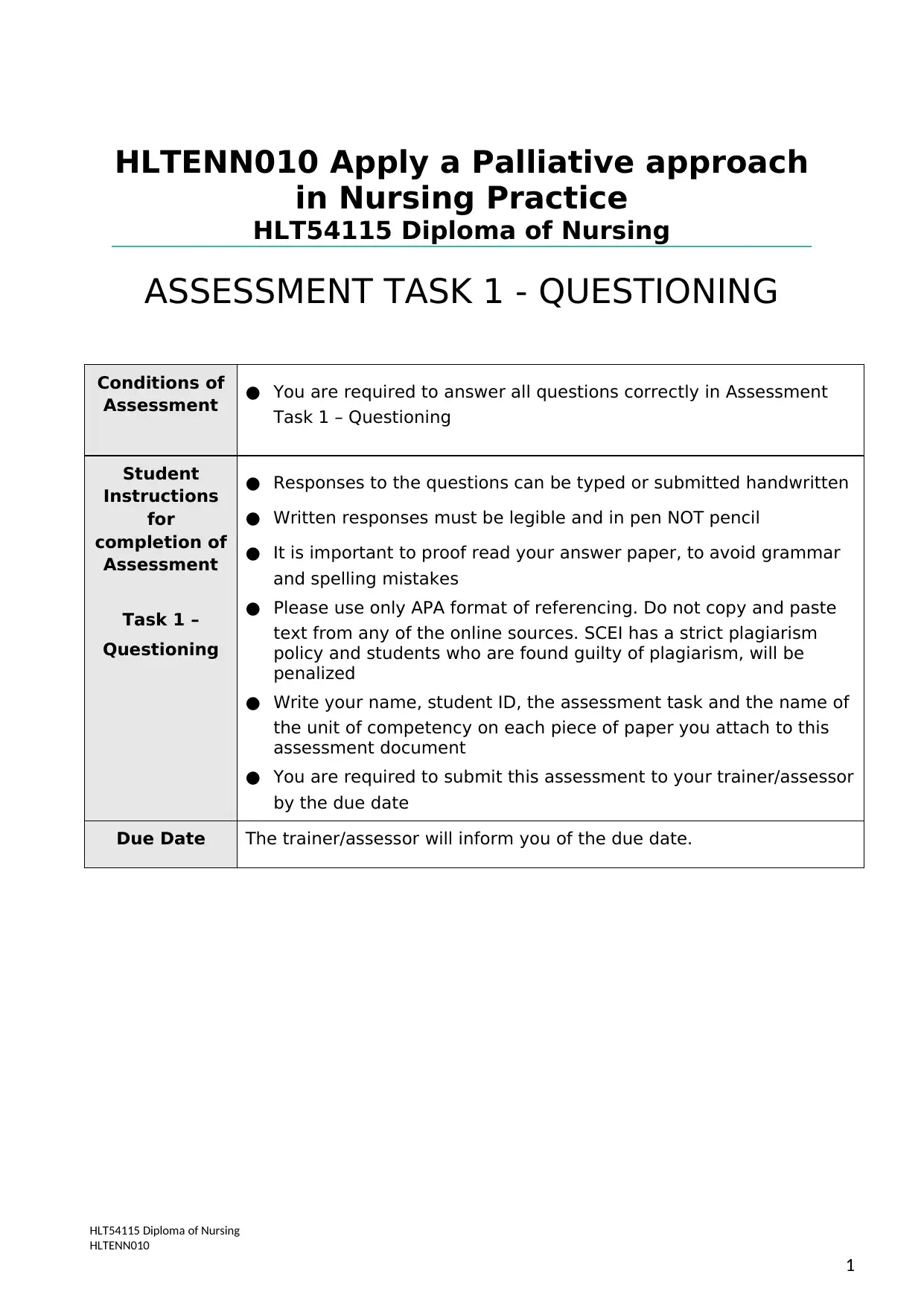
Student Assessment
HLTENN010 Apply a Palliative approach
in Nursing Practice
HLT54115 Diploma of Nursing
ASSESSMENT TASK 1 - QUESTIONING
Conditions of
Assessment ● You are required to answer all questions correctly in Assessment
Task 1 – Questioning
Student
Instructions
for
completion of
Assessment
Task 1 –
Questioning
● Responses to the questions can be typed or submitted handwritten
● Written responses must be legible and in pen NOT pencil
● It is important to proof read your answer paper, to avoid grammar
and spelling mistakes
● Please use only APA format of referencing. Do not copy and paste
text from any of the online sources. SCEI has a strict plagiarism
policy and students who are found guilty of plagiarism, will be
penalized
● Write your name, student ID, the assessment task and the name of
the unit of competency on each piece of paper you attach to this
assessment document
● You are required to submit this assessment to your trainer/assessor
by the due date
Due Date The trainer/assessor will inform you of the due date.
HLT54115 Diploma of Nursing
HLTENN010
1
HLTENN010 Apply a Palliative approach
in Nursing Practice
HLT54115 Diploma of Nursing
ASSESSMENT TASK 1 - QUESTIONING
Conditions of
Assessment ● You are required to answer all questions correctly in Assessment
Task 1 – Questioning
Student
Instructions
for
completion of
Assessment
Task 1 –
Questioning
● Responses to the questions can be typed or submitted handwritten
● Written responses must be legible and in pen NOT pencil
● It is important to proof read your answer paper, to avoid grammar
and spelling mistakes
● Please use only APA format of referencing. Do not copy and paste
text from any of the online sources. SCEI has a strict plagiarism
policy and students who are found guilty of plagiarism, will be
penalized
● Write your name, student ID, the assessment task and the name of
the unit of competency on each piece of paper you attach to this
assessment document
● You are required to submit this assessment to your trainer/assessor
by the due date
Due Date The trainer/assessor will inform you of the due date.
HLT54115 Diploma of Nursing
HLTENN010
1
Paraphrase This Document
Need a fresh take? Get an instant paraphrase of this document with our AI Paraphraser
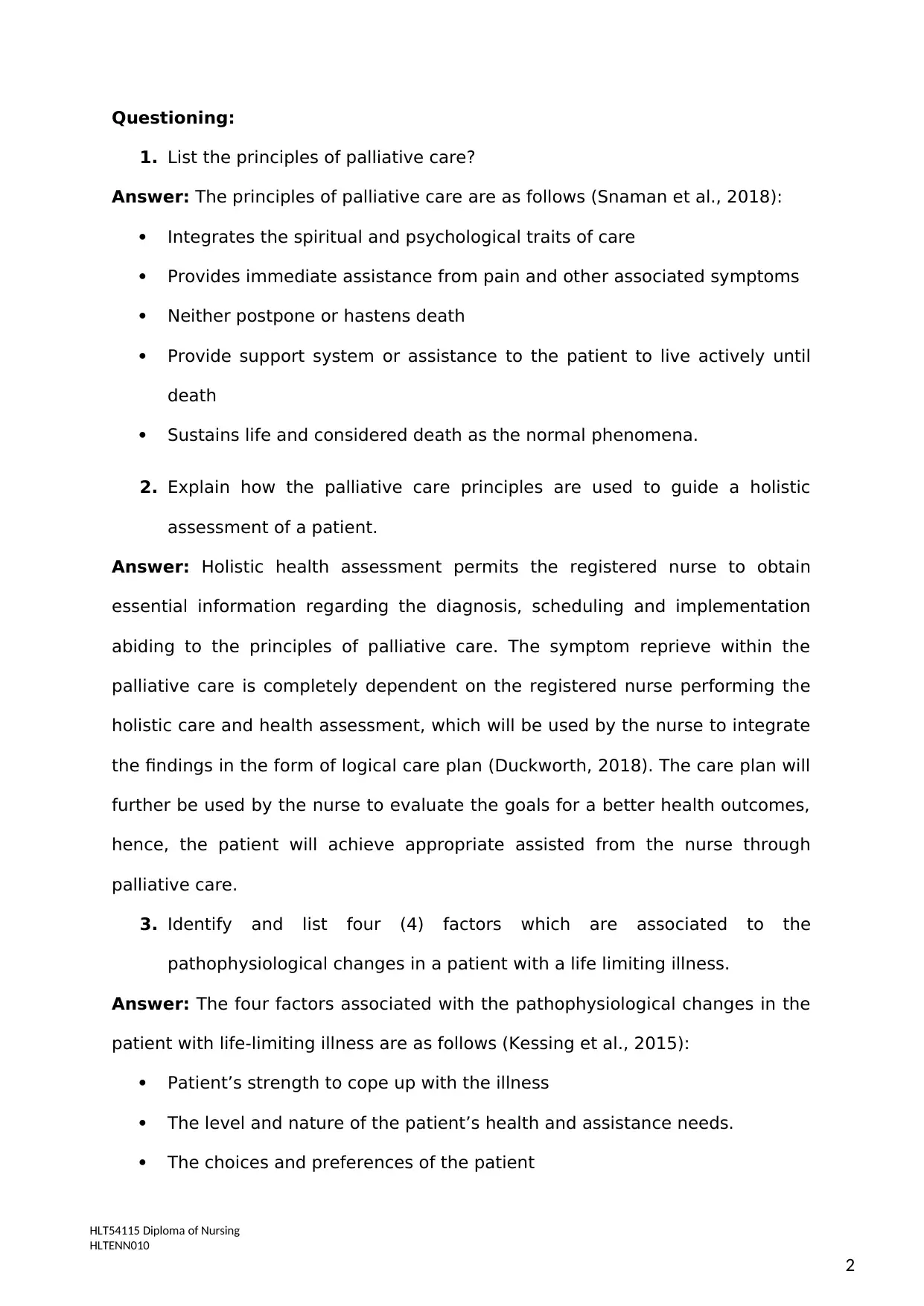
Student Assessment
Questioning:
1. List the principles of palliative care?
Answer: The principles of palliative care are as follows (Snaman et al., 2018):
Integrates the spiritual and psychological traits of care
Provides immediate assistance from pain and other associated symptoms
Neither postpone or hastens death
Provide support system or assistance to the patient to live actively until
death
Sustains life and considered death as the normal phenomena.
2. Explain how the palliative care principles are used to guide a holistic
assessment of a patient.
Answer: Holistic health assessment permits the registered nurse to obtain
essential information regarding the diagnosis, scheduling and implementation
abiding to the principles of palliative care. The symptom reprieve within the
palliative care is completely dependent on the registered nurse performing the
holistic care and health assessment, which will be used by the nurse to integrate
the findings in the form of logical care plan (Duckworth, 2018). The care plan will
further be used by the nurse to evaluate the goals for a better health outcomes,
hence, the patient will achieve appropriate assisted from the nurse through
palliative care.
3. Identify and list four (4) factors which are associated to the
pathophysiological changes in a patient with a life limiting illness.
Answer: The four factors associated with the pathophysiological changes in the
patient with life-limiting illness are as follows (Kessing et al., 2015):
Patient’s strength to cope up with the illness
The level and nature of the patient’s health and assistance needs.
The choices and preferences of the patient
HLT54115 Diploma of Nursing
HLTENN010
2
Questioning:
1. List the principles of palliative care?
Answer: The principles of palliative care are as follows (Snaman et al., 2018):
Integrates the spiritual and psychological traits of care
Provides immediate assistance from pain and other associated symptoms
Neither postpone or hastens death
Provide support system or assistance to the patient to live actively until
death
Sustains life and considered death as the normal phenomena.
2. Explain how the palliative care principles are used to guide a holistic
assessment of a patient.
Answer: Holistic health assessment permits the registered nurse to obtain
essential information regarding the diagnosis, scheduling and implementation
abiding to the principles of palliative care. The symptom reprieve within the
palliative care is completely dependent on the registered nurse performing the
holistic care and health assessment, which will be used by the nurse to integrate
the findings in the form of logical care plan (Duckworth, 2018). The care plan will
further be used by the nurse to evaluate the goals for a better health outcomes,
hence, the patient will achieve appropriate assisted from the nurse through
palliative care.
3. Identify and list four (4) factors which are associated to the
pathophysiological changes in a patient with a life limiting illness.
Answer: The four factors associated with the pathophysiological changes in the
patient with life-limiting illness are as follows (Kessing et al., 2015):
Patient’s strength to cope up with the illness
The level and nature of the patient’s health and assistance needs.
The choices and preferences of the patient
HLT54115 Diploma of Nursing
HLTENN010
2
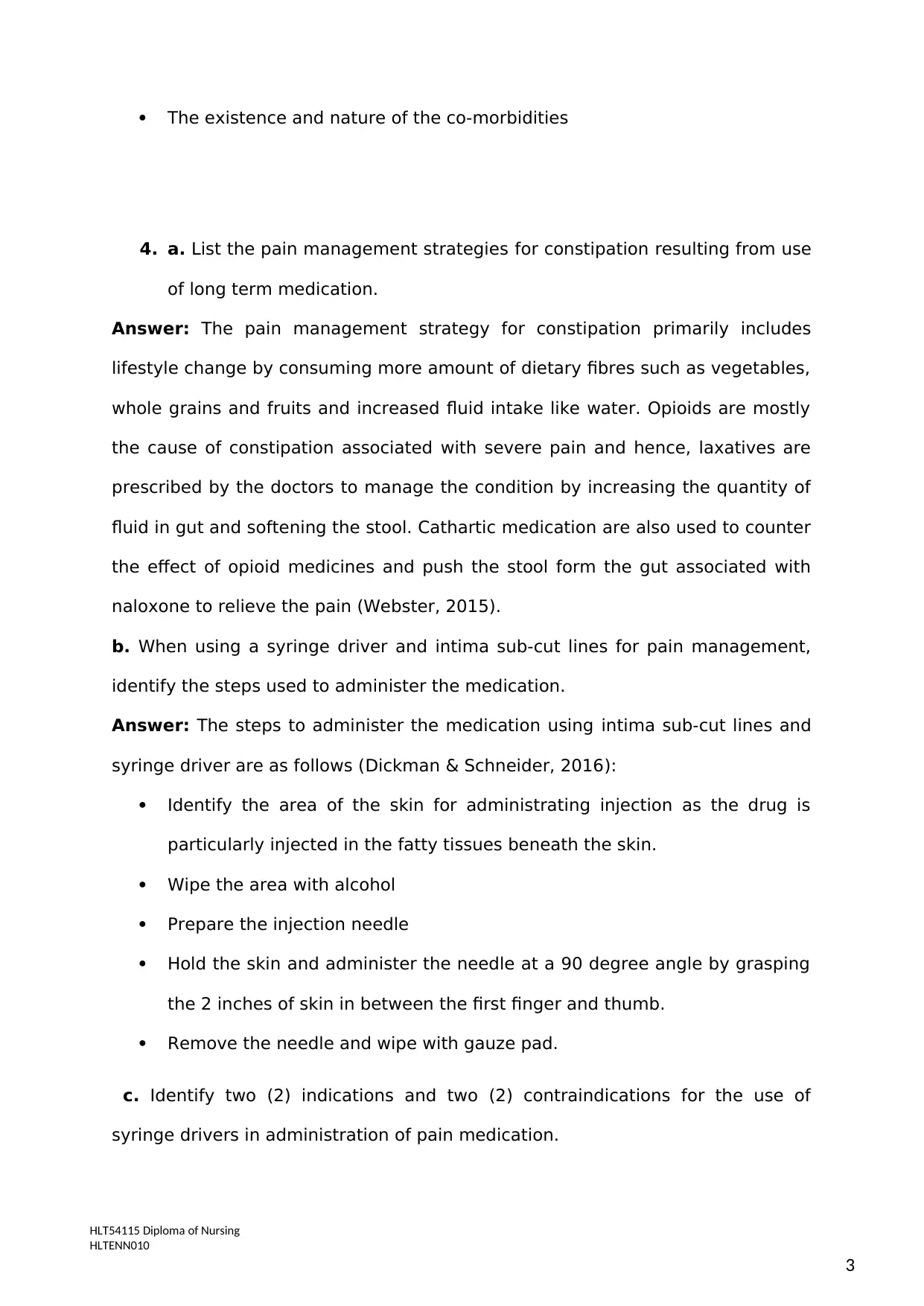
Student Assessment
The existence and nature of the co-morbidities
4. a. List the pain management strategies for constipation resulting from use
of long term medication.
Answer: The pain management strategy for constipation primarily includes
lifestyle change by consuming more amount of dietary fibres such as vegetables,
whole grains and fruits and increased fluid intake like water. Opioids are mostly
the cause of constipation associated with severe pain and hence, laxatives are
prescribed by the doctors to manage the condition by increasing the quantity of
fluid in gut and softening the stool. Cathartic medication are also used to counter
the effect of opioid medicines and push the stool form the gut associated with
naloxone to relieve the pain (Webster, 2015).
b. When using a syringe driver and intima sub-cut lines for pain management,
identify the steps used to administer the medication.
Answer: The steps to administer the medication using intima sub-cut lines and
syringe driver are as follows (Dickman & Schneider, 2016):
Identify the area of the skin for administrating injection as the drug is
particularly injected in the fatty tissues beneath the skin.
Wipe the area with alcohol
Prepare the injection needle
Hold the skin and administer the needle at a 90 degree angle by grasping
the 2 inches of skin in between the first finger and thumb.
Remove the needle and wipe with gauze pad.
c. Identify two (2) indications and two (2) contraindications for the use of
syringe drivers in administration of pain medication.
HLT54115 Diploma of Nursing
HLTENN010
3
The existence and nature of the co-morbidities
4. a. List the pain management strategies for constipation resulting from use
of long term medication.
Answer: The pain management strategy for constipation primarily includes
lifestyle change by consuming more amount of dietary fibres such as vegetables,
whole grains and fruits and increased fluid intake like water. Opioids are mostly
the cause of constipation associated with severe pain and hence, laxatives are
prescribed by the doctors to manage the condition by increasing the quantity of
fluid in gut and softening the stool. Cathartic medication are also used to counter
the effect of opioid medicines and push the stool form the gut associated with
naloxone to relieve the pain (Webster, 2015).
b. When using a syringe driver and intima sub-cut lines for pain management,
identify the steps used to administer the medication.
Answer: The steps to administer the medication using intima sub-cut lines and
syringe driver are as follows (Dickman & Schneider, 2016):
Identify the area of the skin for administrating injection as the drug is
particularly injected in the fatty tissues beneath the skin.
Wipe the area with alcohol
Prepare the injection needle
Hold the skin and administer the needle at a 90 degree angle by grasping
the 2 inches of skin in between the first finger and thumb.
Remove the needle and wipe with gauze pad.
c. Identify two (2) indications and two (2) contraindications for the use of
syringe drivers in administration of pain medication.
HLT54115 Diploma of Nursing
HLTENN010
3
⊘ This is a preview!⊘
Do you want full access?
Subscribe today to unlock all pages.

Trusted by 1+ million students worldwide
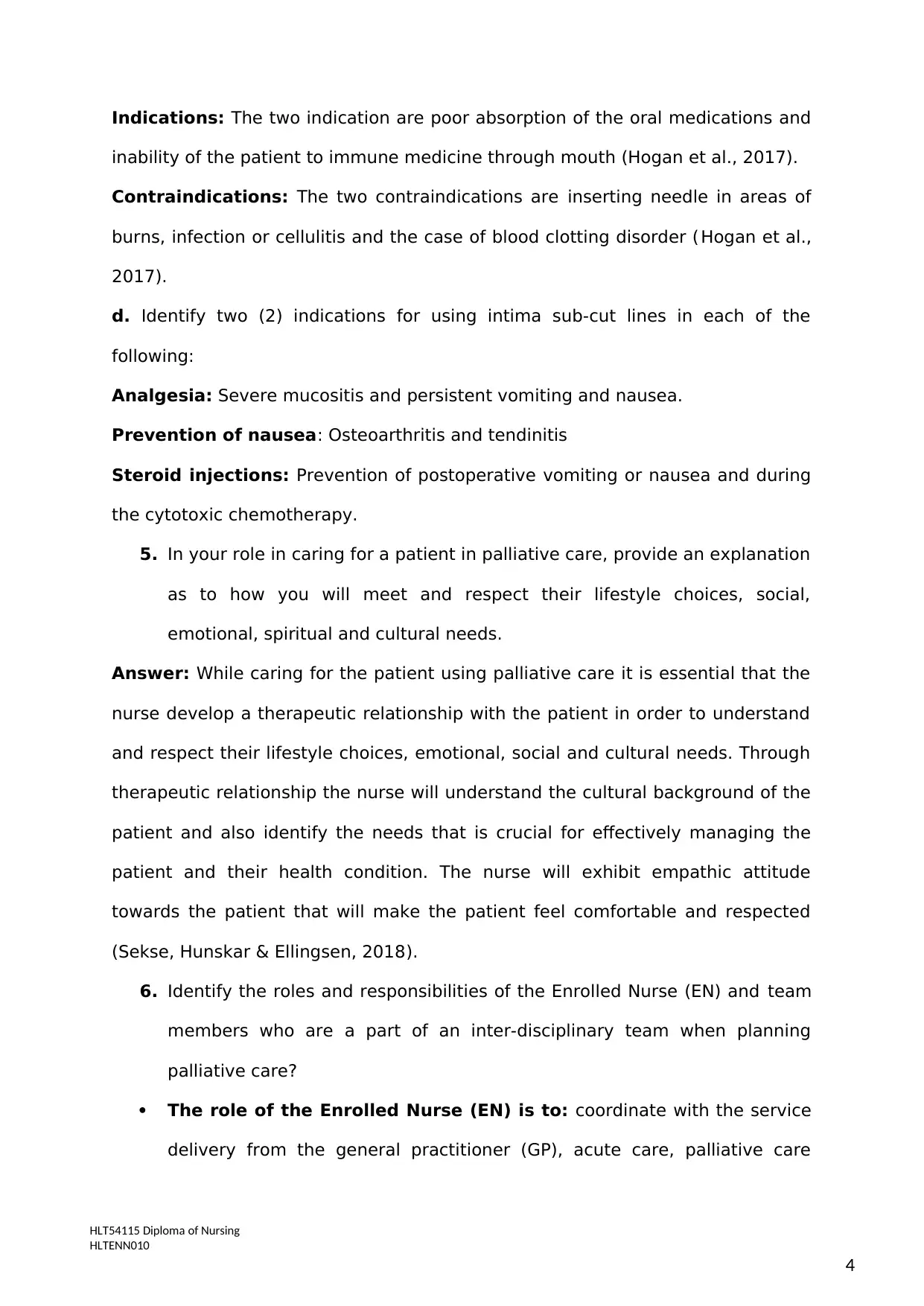
Student Assessment
Indications: The two indication are poor absorption of the oral medications and
inability of the patient to immune medicine through mouth (Hogan et al., 2017).
Contraindications: The two contraindications are inserting needle in areas of
burns, infection or cellulitis and the case of blood clotting disorder ( Hogan et al.,
2017).
d. Identify two (2) indications for using intima sub-cut lines in each of the
following:
Analgesia: Severe mucositis and persistent vomiting and nausea.
Prevention of nausea: Osteoarthritis and tendinitis
Steroid injections: Prevention of postoperative vomiting or nausea and during
the cytotoxic chemotherapy.
5. In your role in caring for a patient in palliative care, provide an explanation
as to how you will meet and respect their lifestyle choices, social,
emotional, spiritual and cultural needs.
Answer: While caring for the patient using palliative care it is essential that the
nurse develop a therapeutic relationship with the patient in order to understand
and respect their lifestyle choices, emotional, social and cultural needs. Through
therapeutic relationship the nurse will understand the cultural background of the
patient and also identify the needs that is crucial for effectively managing the
patient and their health condition. The nurse will exhibit empathic attitude
towards the patient that will make the patient feel comfortable and respected
(Sekse, Hunskar & Ellingsen, 2018).
6. Identify the roles and responsibilities of the Enrolled Nurse (EN) and team
members who are a part of an inter-disciplinary team when planning
palliative care?
The role of the Enrolled Nurse (EN) is to: coordinate with the service
delivery from the general practitioner (GP), acute care, palliative care
HLT54115 Diploma of Nursing
HLTENN010
4
Indications: The two indication are poor absorption of the oral medications and
inability of the patient to immune medicine through mouth (Hogan et al., 2017).
Contraindications: The two contraindications are inserting needle in areas of
burns, infection or cellulitis and the case of blood clotting disorder ( Hogan et al.,
2017).
d. Identify two (2) indications for using intima sub-cut lines in each of the
following:
Analgesia: Severe mucositis and persistent vomiting and nausea.
Prevention of nausea: Osteoarthritis and tendinitis
Steroid injections: Prevention of postoperative vomiting or nausea and during
the cytotoxic chemotherapy.
5. In your role in caring for a patient in palliative care, provide an explanation
as to how you will meet and respect their lifestyle choices, social,
emotional, spiritual and cultural needs.
Answer: While caring for the patient using palliative care it is essential that the
nurse develop a therapeutic relationship with the patient in order to understand
and respect their lifestyle choices, emotional, social and cultural needs. Through
therapeutic relationship the nurse will understand the cultural background of the
patient and also identify the needs that is crucial for effectively managing the
patient and their health condition. The nurse will exhibit empathic attitude
towards the patient that will make the patient feel comfortable and respected
(Sekse, Hunskar & Ellingsen, 2018).
6. Identify the roles and responsibilities of the Enrolled Nurse (EN) and team
members who are a part of an inter-disciplinary team when planning
palliative care?
The role of the Enrolled Nurse (EN) is to: coordinate with the service
delivery from the general practitioner (GP), acute care, palliative care
HLT54115 Diploma of Nursing
HLTENN010
4
Paraphrase This Document
Need a fresh take? Get an instant paraphrase of this document with our AI Paraphraser
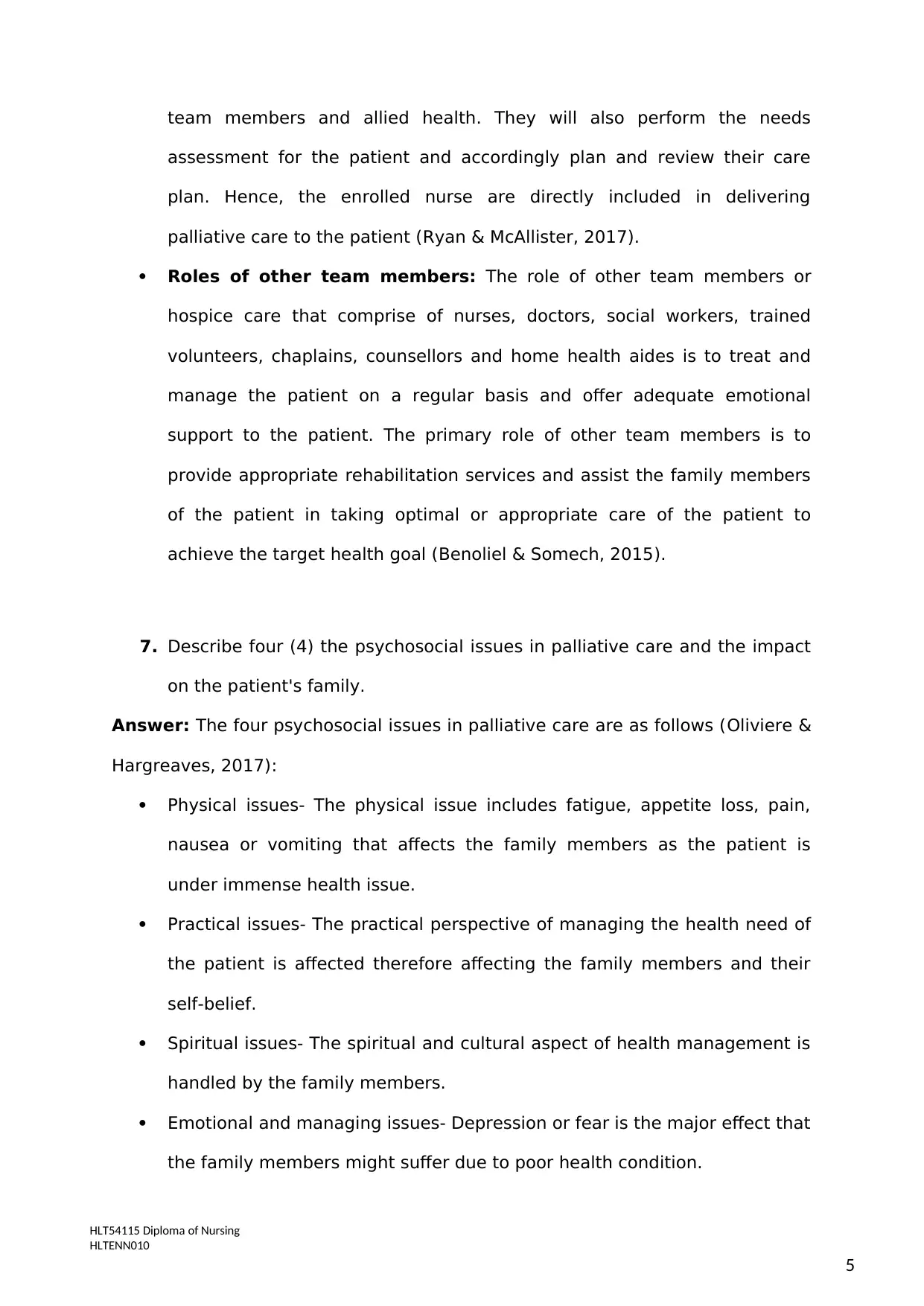
Student Assessment
team members and allied health. They will also perform the needs
assessment for the patient and accordingly plan and review their care
plan. Hence, the enrolled nurse are directly included in delivering
palliative care to the patient (Ryan & McAllister, 2017).
Roles of other team members: The role of other team members or
hospice care that comprise of nurses, doctors, social workers, trained
volunteers, chaplains, counsellors and home health aides is to treat and
manage the patient on a regular basis and offer adequate emotional
support to the patient. The primary role of other team members is to
provide appropriate rehabilitation services and assist the family members
of the patient in taking optimal or appropriate care of the patient to
achieve the target health goal (Benoliel & Somech, 2015).
7. Describe four (4) the psychosocial issues in palliative care and the impact
on the patient's family.
Answer: The four psychosocial issues in palliative care are as follows (Oliviere &
Hargreaves, 2017):
Physical issues- The physical issue includes fatigue, appetite loss, pain,
nausea or vomiting that affects the family members as the patient is
under immense health issue.
Practical issues- The practical perspective of managing the health need of
the patient is affected therefore affecting the family members and their
self-belief.
Spiritual issues- The spiritual and cultural aspect of health management is
handled by the family members.
Emotional and managing issues- Depression or fear is the major effect that
the family members might suffer due to poor health condition.
HLT54115 Diploma of Nursing
HLTENN010
5
team members and allied health. They will also perform the needs
assessment for the patient and accordingly plan and review their care
plan. Hence, the enrolled nurse are directly included in delivering
palliative care to the patient (Ryan & McAllister, 2017).
Roles of other team members: The role of other team members or
hospice care that comprise of nurses, doctors, social workers, trained
volunteers, chaplains, counsellors and home health aides is to treat and
manage the patient on a regular basis and offer adequate emotional
support to the patient. The primary role of other team members is to
provide appropriate rehabilitation services and assist the family members
of the patient in taking optimal or appropriate care of the patient to
achieve the target health goal (Benoliel & Somech, 2015).
7. Describe four (4) the psychosocial issues in palliative care and the impact
on the patient's family.
Answer: The four psychosocial issues in palliative care are as follows (Oliviere &
Hargreaves, 2017):
Physical issues- The physical issue includes fatigue, appetite loss, pain,
nausea or vomiting that affects the family members as the patient is
under immense health issue.
Practical issues- The practical perspective of managing the health need of
the patient is affected therefore affecting the family members and their
self-belief.
Spiritual issues- The spiritual and cultural aspect of health management is
handled by the family members.
Emotional and managing issues- Depression or fear is the major effect that
the family members might suffer due to poor health condition.
HLT54115 Diploma of Nursing
HLTENN010
5
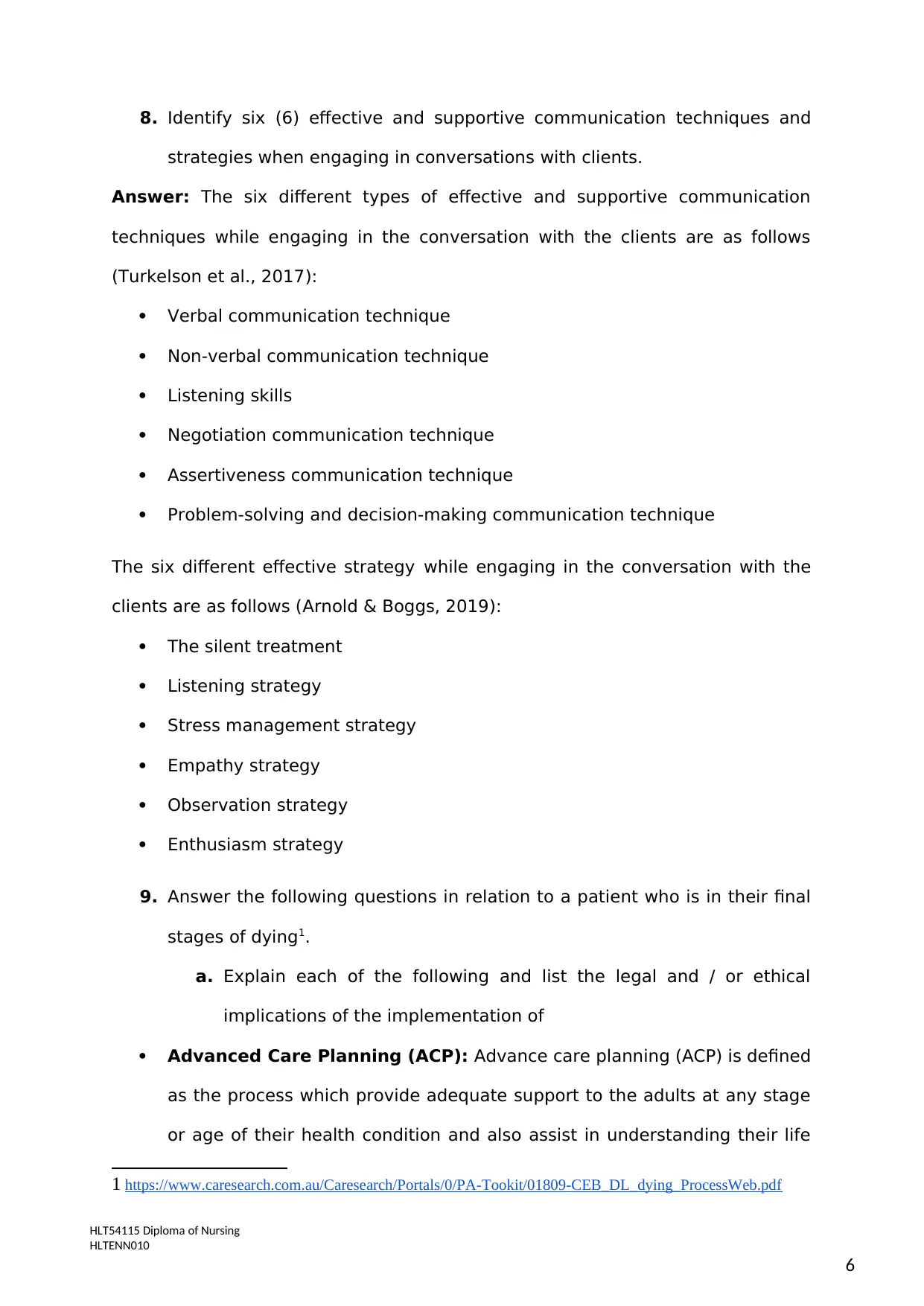
Student Assessment
8. Identify six (6) effective and supportive communication techniques and
strategies when engaging in conversations with clients.
Answer: The six different types of effective and supportive communication
techniques while engaging in the conversation with the clients are as follows
(Turkelson et al., 2017):
Verbal communication technique
Non-verbal communication technique
Listening skills
Negotiation communication technique
Assertiveness communication technique
Problem-solving and decision-making communication technique
The six different effective strategy while engaging in the conversation with the
clients are as follows (Arnold & Boggs, 2019):
The silent treatment
Listening strategy
Stress management strategy
Empathy strategy
Observation strategy
Enthusiasm strategy
9. Answer the following questions in relation to a patient who is in their final
stages of dying1.
a. Explain each of the following and list the legal and / or ethical
implications of the implementation of
Advanced Care Planning (ACP): Advance care planning (ACP) is defined
as the process which provide adequate support to the adults at any stage
or age of their health condition and also assist in understanding their life
1 https://www.caresearch.com.au/Caresearch/Portals/0/PA-Tookit/01809-CEB_DL_dying_ProcessWeb.pdf
HLT54115 Diploma of Nursing
HLTENN010
6
8. Identify six (6) effective and supportive communication techniques and
strategies when engaging in conversations with clients.
Answer: The six different types of effective and supportive communication
techniques while engaging in the conversation with the clients are as follows
(Turkelson et al., 2017):
Verbal communication technique
Non-verbal communication technique
Listening skills
Negotiation communication technique
Assertiveness communication technique
Problem-solving and decision-making communication technique
The six different effective strategy while engaging in the conversation with the
clients are as follows (Arnold & Boggs, 2019):
The silent treatment
Listening strategy
Stress management strategy
Empathy strategy
Observation strategy
Enthusiasm strategy
9. Answer the following questions in relation to a patient who is in their final
stages of dying1.
a. Explain each of the following and list the legal and / or ethical
implications of the implementation of
Advanced Care Planning (ACP): Advance care planning (ACP) is defined
as the process which provide adequate support to the adults at any stage
or age of their health condition and also assist in understanding their life
1 https://www.caresearch.com.au/Caresearch/Portals/0/PA-Tookit/01809-CEB_DL_dying_ProcessWeb.pdf
HLT54115 Diploma of Nursing
HLTENN010
6
⊘ This is a preview!⊘
Do you want full access?
Subscribe today to unlock all pages.

Trusted by 1+ million students worldwide
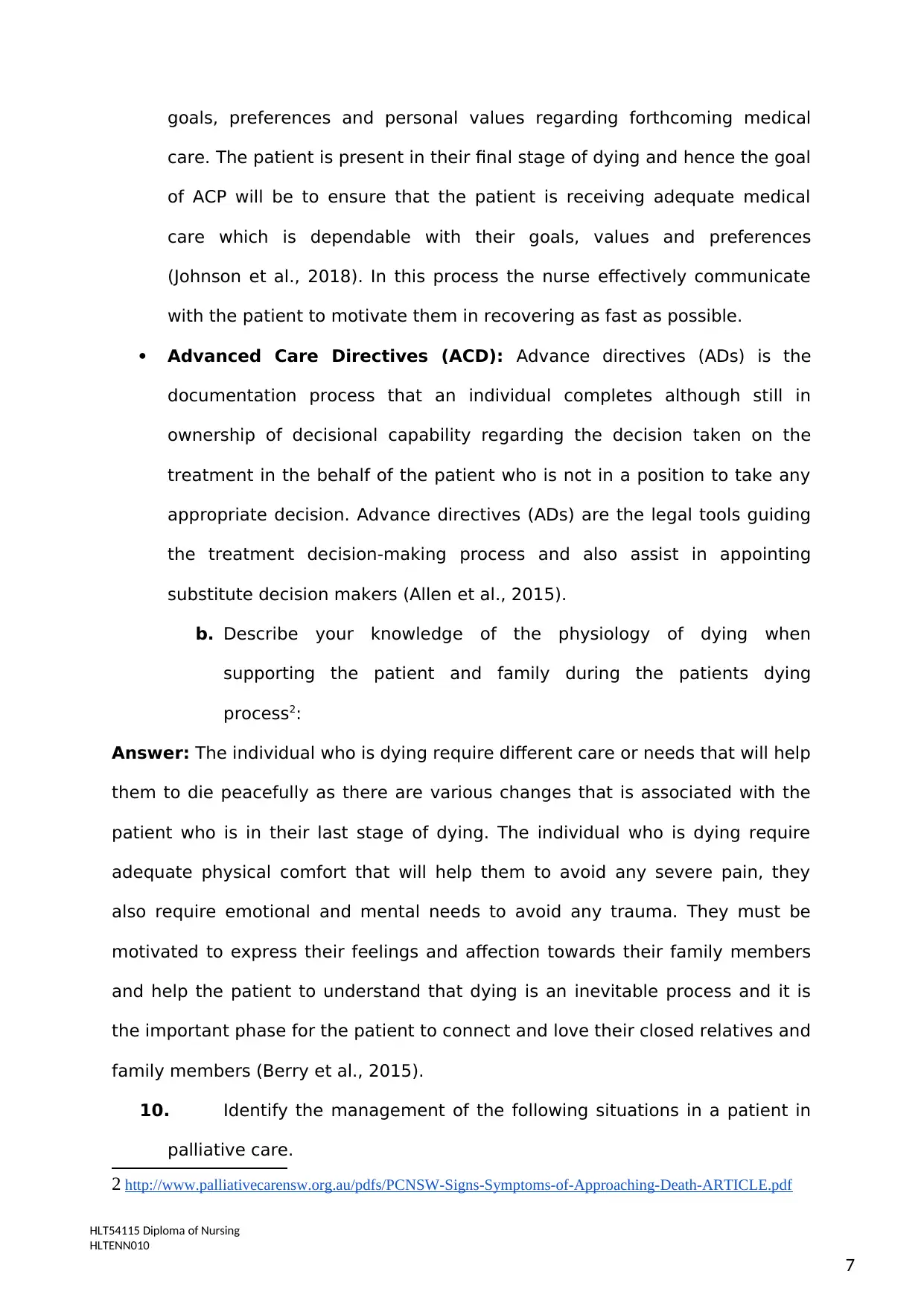
Student Assessment
goals, preferences and personal values regarding forthcoming medical
care. The patient is present in their final stage of dying and hence the goal
of ACP will be to ensure that the patient is receiving adequate medical
care which is dependable with their goals, values and preferences
(Johnson et al., 2018). In this process the nurse effectively communicate
with the patient to motivate them in recovering as fast as possible.
Advanced Care Directives (ACD): Advance directives (ADs) is the
documentation process that an individual completes although still in
ownership of decisional capability regarding the decision taken on the
treatment in the behalf of the patient who is not in a position to take any
appropriate decision. Advance directives (ADs) are the legal tools guiding
the treatment decision-making process and also assist in appointing
substitute decision makers (Allen et al., 2015).
b. Describe your knowledge of the physiology of dying when
supporting the patient and family during the patients dying
process2:
Answer: The individual who is dying require different care or needs that will help
them to die peacefully as there are various changes that is associated with the
patient who is in their last stage of dying. The individual who is dying require
adequate physical comfort that will help them to avoid any severe pain, they
also require emotional and mental needs to avoid any trauma. They must be
motivated to express their feelings and affection towards their family members
and help the patient to understand that dying is an inevitable process and it is
the important phase for the patient to connect and love their closed relatives and
family members (Berry et al., 2015).
10. Identify the management of the following situations in a patient in
palliative care.
2 http://www.palliativecarensw.org.au/pdfs/PCNSW-Signs-Symptoms-of-Approaching-Death-ARTICLE.pdf
HLT54115 Diploma of Nursing
HLTENN010
7
goals, preferences and personal values regarding forthcoming medical
care. The patient is present in their final stage of dying and hence the goal
of ACP will be to ensure that the patient is receiving adequate medical
care which is dependable with their goals, values and preferences
(Johnson et al., 2018). In this process the nurse effectively communicate
with the patient to motivate them in recovering as fast as possible.
Advanced Care Directives (ACD): Advance directives (ADs) is the
documentation process that an individual completes although still in
ownership of decisional capability regarding the decision taken on the
treatment in the behalf of the patient who is not in a position to take any
appropriate decision. Advance directives (ADs) are the legal tools guiding
the treatment decision-making process and also assist in appointing
substitute decision makers (Allen et al., 2015).
b. Describe your knowledge of the physiology of dying when
supporting the patient and family during the patients dying
process2:
Answer: The individual who is dying require different care or needs that will help
them to die peacefully as there are various changes that is associated with the
patient who is in their last stage of dying. The individual who is dying require
adequate physical comfort that will help them to avoid any severe pain, they
also require emotional and mental needs to avoid any trauma. They must be
motivated to express their feelings and affection towards their family members
and help the patient to understand that dying is an inevitable process and it is
the important phase for the patient to connect and love their closed relatives and
family members (Berry et al., 2015).
10. Identify the management of the following situations in a patient in
palliative care.
2 http://www.palliativecarensw.org.au/pdfs/PCNSW-Signs-Symptoms-of-Approaching-Death-ARTICLE.pdf
HLT54115 Diploma of Nursing
HLTENN010
7
Paraphrase This Document
Need a fresh take? Get an instant paraphrase of this document with our AI Paraphraser
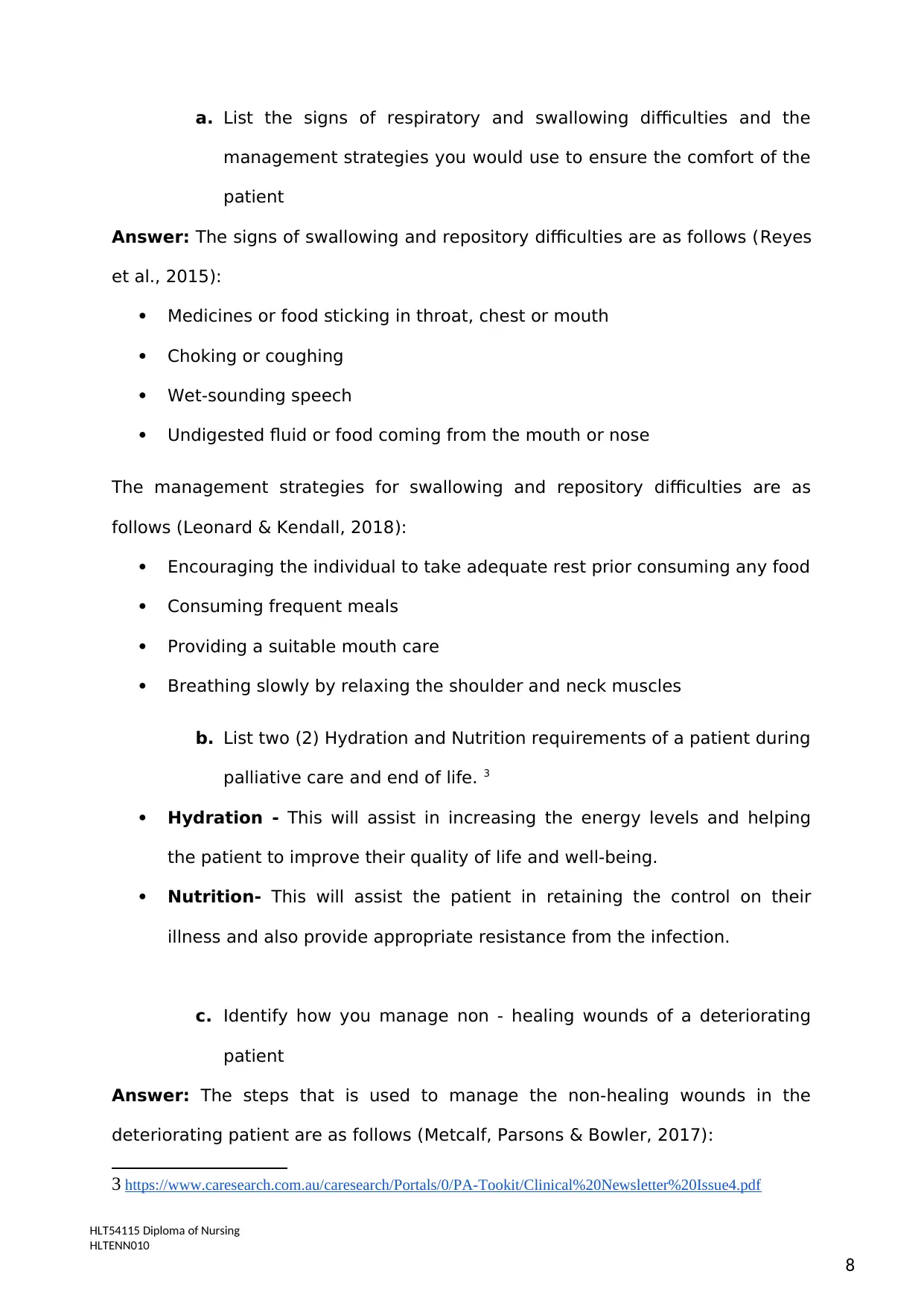
Student Assessment
a. List the signs of respiratory and swallowing difficulties and the
management strategies you would use to ensure the comfort of the
patient
Answer: The signs of swallowing and repository difficulties are as follows (Reyes
et al., 2015):
Medicines or food sticking in throat, chest or mouth
Choking or coughing
Wet-sounding speech
Undigested fluid or food coming from the mouth or nose
The management strategies for swallowing and repository difficulties are as
follows (Leonard & Kendall, 2018):
Encouraging the individual to take adequate rest prior consuming any food
Consuming frequent meals
Providing a suitable mouth care
Breathing slowly by relaxing the shoulder and neck muscles
b. List two (2) Hydration and Nutrition requirements of a patient during
palliative care and end of life. 3
Hydration - This will assist in increasing the energy levels and helping
the patient to improve their quality of life and well-being.
Nutrition- This will assist the patient in retaining the control on their
illness and also provide appropriate resistance from the infection.
c. Identify how you manage non - healing wounds of a deteriorating
patient
Answer: The steps that is used to manage the non-healing wounds in the
deteriorating patient are as follows (Metcalf, Parsons & Bowler, 2017):
3 https://www.caresearch.com.au/caresearch/Portals/0/PA-Tookit/Clinical%20Newsletter%20Issue4.pdf
HLT54115 Diploma of Nursing
HLTENN010
8
a. List the signs of respiratory and swallowing difficulties and the
management strategies you would use to ensure the comfort of the
patient
Answer: The signs of swallowing and repository difficulties are as follows (Reyes
et al., 2015):
Medicines or food sticking in throat, chest or mouth
Choking or coughing
Wet-sounding speech
Undigested fluid or food coming from the mouth or nose
The management strategies for swallowing and repository difficulties are as
follows (Leonard & Kendall, 2018):
Encouraging the individual to take adequate rest prior consuming any food
Consuming frequent meals
Providing a suitable mouth care
Breathing slowly by relaxing the shoulder and neck muscles
b. List two (2) Hydration and Nutrition requirements of a patient during
palliative care and end of life. 3
Hydration - This will assist in increasing the energy levels and helping
the patient to improve their quality of life and well-being.
Nutrition- This will assist the patient in retaining the control on their
illness and also provide appropriate resistance from the infection.
c. Identify how you manage non - healing wounds of a deteriorating
patient
Answer: The steps that is used to manage the non-healing wounds in the
deteriorating patient are as follows (Metcalf, Parsons & Bowler, 2017):
3 https://www.caresearch.com.au/caresearch/Portals/0/PA-Tookit/Clinical%20Newsletter%20Issue4.pdf
HLT54115 Diploma of Nursing
HLTENN010
8
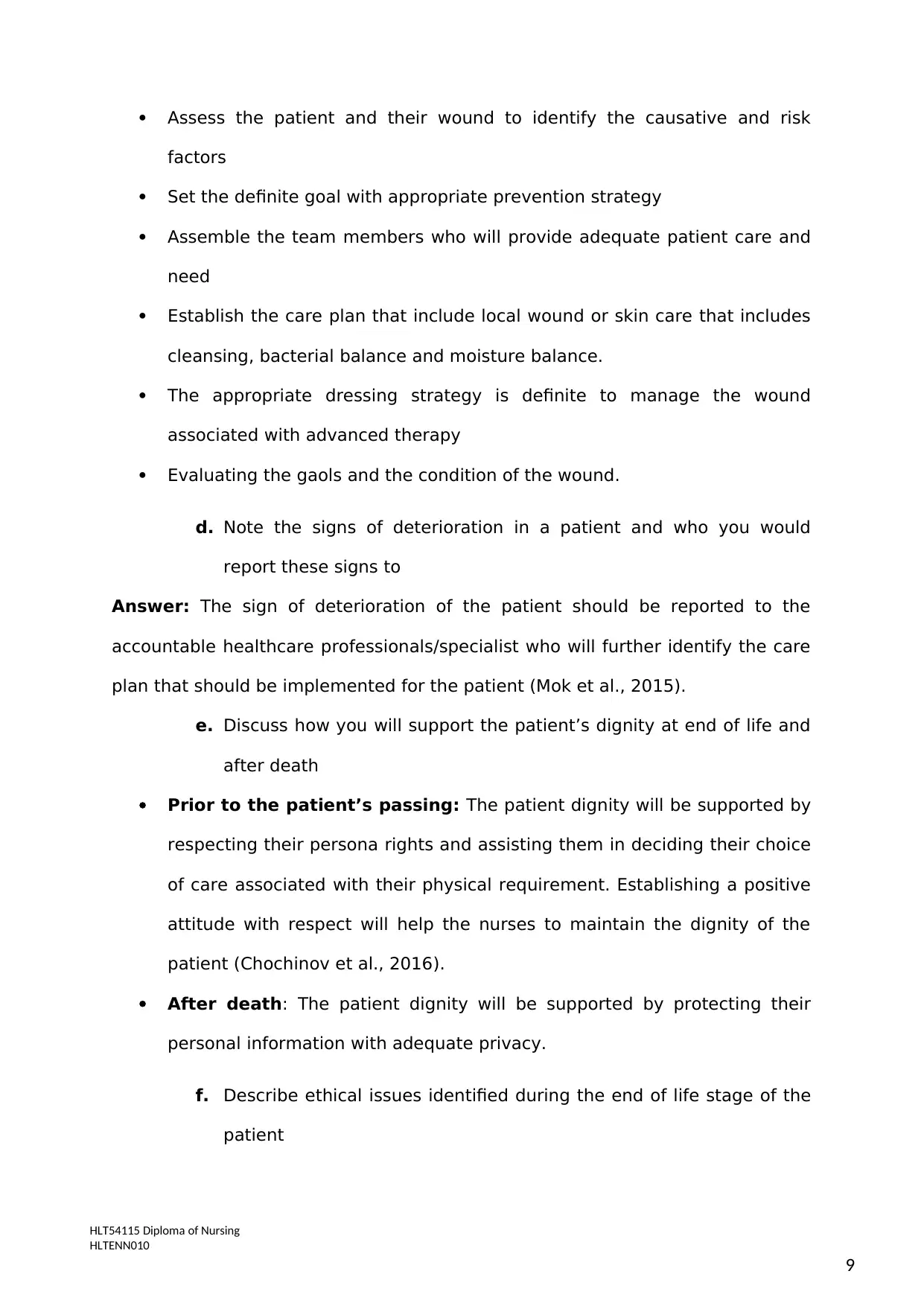
Student Assessment
Assess the patient and their wound to identify the causative and risk
factors
Set the definite goal with appropriate prevention strategy
Assemble the team members who will provide adequate patient care and
need
Establish the care plan that include local wound or skin care that includes
cleansing, bacterial balance and moisture balance.
The appropriate dressing strategy is definite to manage the wound
associated with advanced therapy
Evaluating the gaols and the condition of the wound.
d. Note the signs of deterioration in a patient and who you would
report these signs to
Answer: The sign of deterioration of the patient should be reported to the
accountable healthcare professionals/specialist who will further identify the care
plan that should be implemented for the patient (Mok et al., 2015).
e. Discuss how you will support the patient’s dignity at end of life and
after death
Prior to the patient’s passing: The patient dignity will be supported by
respecting their persona rights and assisting them in deciding their choice
of care associated with their physical requirement. Establishing a positive
attitude with respect will help the nurses to maintain the dignity of the
patient (Chochinov et al., 2016).
After death: The patient dignity will be supported by protecting their
personal information with adequate privacy.
f. Describe ethical issues identified during the end of life stage of the
patient
HLT54115 Diploma of Nursing
HLTENN010
9
Assess the patient and their wound to identify the causative and risk
factors
Set the definite goal with appropriate prevention strategy
Assemble the team members who will provide adequate patient care and
need
Establish the care plan that include local wound or skin care that includes
cleansing, bacterial balance and moisture balance.
The appropriate dressing strategy is definite to manage the wound
associated with advanced therapy
Evaluating the gaols and the condition of the wound.
d. Note the signs of deterioration in a patient and who you would
report these signs to
Answer: The sign of deterioration of the patient should be reported to the
accountable healthcare professionals/specialist who will further identify the care
plan that should be implemented for the patient (Mok et al., 2015).
e. Discuss how you will support the patient’s dignity at end of life and
after death
Prior to the patient’s passing: The patient dignity will be supported by
respecting their persona rights and assisting them in deciding their choice
of care associated with their physical requirement. Establishing a positive
attitude with respect will help the nurses to maintain the dignity of the
patient (Chochinov et al., 2016).
After death: The patient dignity will be supported by protecting their
personal information with adequate privacy.
f. Describe ethical issues identified during the end of life stage of the
patient
HLT54115 Diploma of Nursing
HLTENN010
9
⊘ This is a preview!⊘
Do you want full access?
Subscribe today to unlock all pages.

Trusted by 1+ million students worldwide
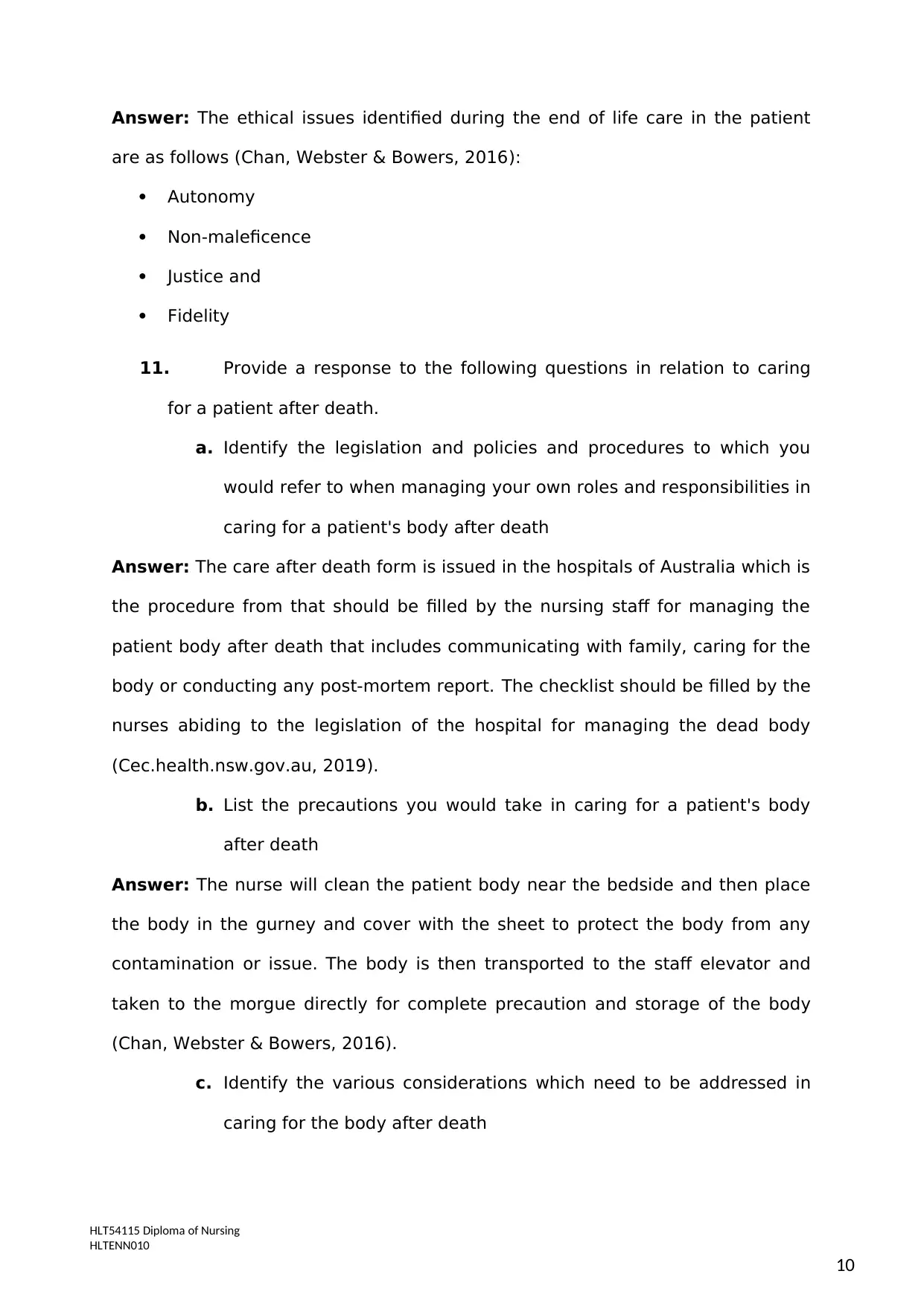
Student Assessment
Answer: The ethical issues identified during the end of life care in the patient
are as follows (Chan, Webster & Bowers, 2016):
Autonomy
Non-maleficence
Justice and
Fidelity
11. Provide a response to the following questions in relation to caring
for a patient after death.
a. Identify the legislation and policies and procedures to which you
would refer to when managing your own roles and responsibilities in
caring for a patient's body after death
Answer: The care after death form is issued in the hospitals of Australia which is
the procedure from that should be filled by the nursing staff for managing the
patient body after death that includes communicating with family, caring for the
body or conducting any post-mortem report. The checklist should be filled by the
nurses abiding to the legislation of the hospital for managing the dead body
(Cec.health.nsw.gov.au, 2019).
b. List the precautions you would take in caring for a patient's body
after death
Answer: The nurse will clean the patient body near the bedside and then place
the body in the gurney and cover with the sheet to protect the body from any
contamination or issue. The body is then transported to the staff elevator and
taken to the morgue directly for complete precaution and storage of the body
(Chan, Webster & Bowers, 2016).
c. Identify the various considerations which need to be addressed in
caring for the body after death
HLT54115 Diploma of Nursing
HLTENN010
10
Answer: The ethical issues identified during the end of life care in the patient
are as follows (Chan, Webster & Bowers, 2016):
Autonomy
Non-maleficence
Justice and
Fidelity
11. Provide a response to the following questions in relation to caring
for a patient after death.
a. Identify the legislation and policies and procedures to which you
would refer to when managing your own roles and responsibilities in
caring for a patient's body after death
Answer: The care after death form is issued in the hospitals of Australia which is
the procedure from that should be filled by the nursing staff for managing the
patient body after death that includes communicating with family, caring for the
body or conducting any post-mortem report. The checklist should be filled by the
nurses abiding to the legislation of the hospital for managing the dead body
(Cec.health.nsw.gov.au, 2019).
b. List the precautions you would take in caring for a patient's body
after death
Answer: The nurse will clean the patient body near the bedside and then place
the body in the gurney and cover with the sheet to protect the body from any
contamination or issue. The body is then transported to the staff elevator and
taken to the morgue directly for complete precaution and storage of the body
(Chan, Webster & Bowers, 2016).
c. Identify the various considerations which need to be addressed in
caring for the body after death
HLT54115 Diploma of Nursing
HLTENN010
10
Paraphrase This Document
Need a fresh take? Get an instant paraphrase of this document with our AI Paraphraser
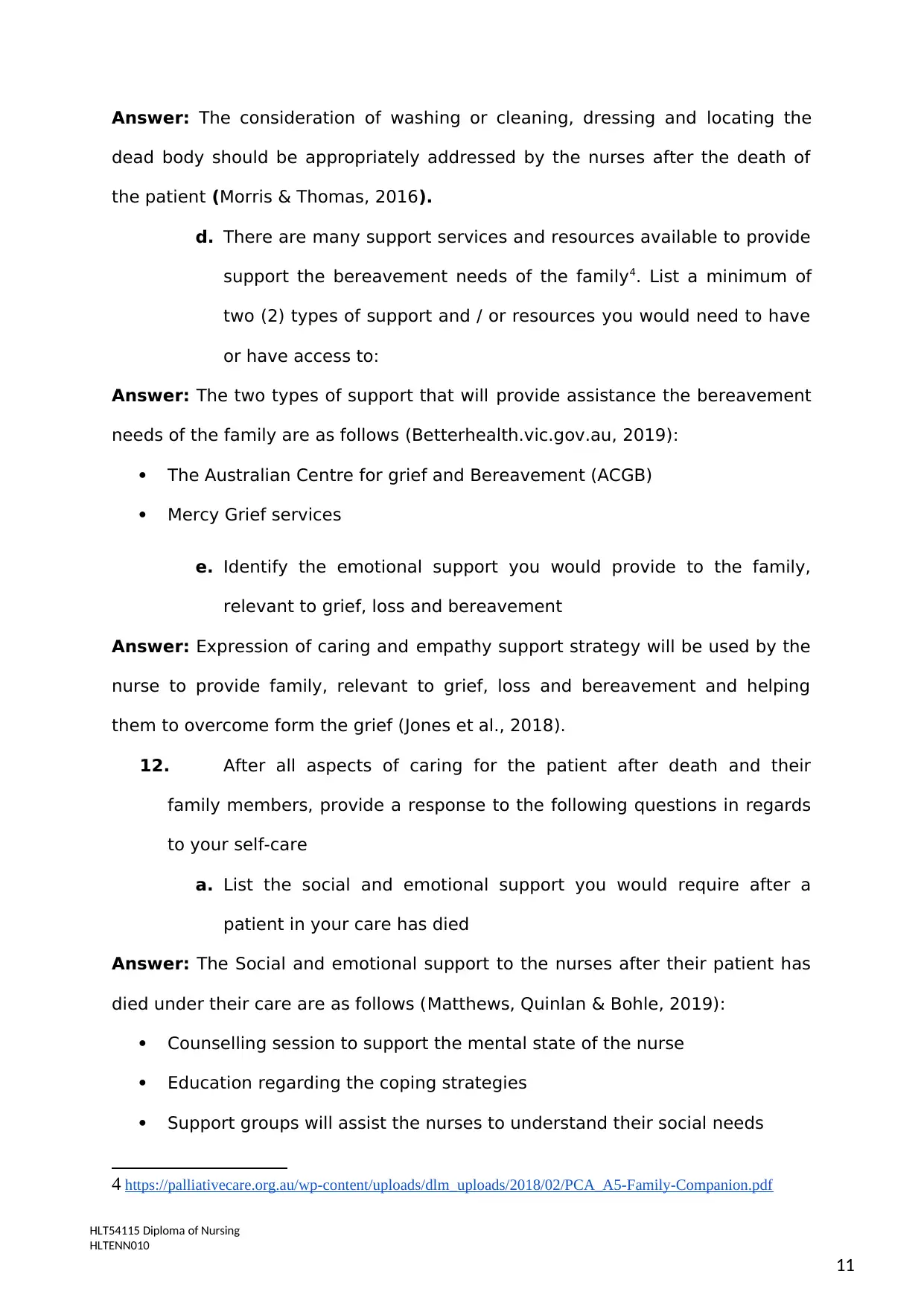
Student Assessment
Answer: The consideration of washing or cleaning, dressing and locating the
dead body should be appropriately addressed by the nurses after the death of
the patient (Morris & Thomas, 2016).
d. There are many support services and resources available to provide
support the bereavement needs of the family4. List a minimum of
two (2) types of support and / or resources you would need to have
or have access to:
Answer: The two types of support that will provide assistance the bereavement
needs of the family are as follows (Betterhealth.vic.gov.au, 2019):
The Australian Centre for grief and Bereavement (ACGB)
Mercy Grief services
e. Identify the emotional support you would provide to the family,
relevant to grief, loss and bereavement
Answer: Expression of caring and empathy support strategy will be used by the
nurse to provide family, relevant to grief, loss and bereavement and helping
them to overcome form the grief (Jones et al., 2018).
12. After all aspects of caring for the patient after death and their
family members, provide a response to the following questions in regards
to your self-care
a. List the social and emotional support you would require after a
patient in your care has died
Answer: The Social and emotional support to the nurses after their patient has
died under their care are as follows (Matthews, Quinlan & Bohle, 2019):
Counselling session to support the mental state of the nurse
Education regarding the coping strategies
Support groups will assist the nurses to understand their social needs
4 https://palliativecare.org.au/wp-content/uploads/dlm_uploads/2018/02/PCA_A5-Family-Companion.pdf
HLT54115 Diploma of Nursing
HLTENN010
11
Answer: The consideration of washing or cleaning, dressing and locating the
dead body should be appropriately addressed by the nurses after the death of
the patient (Morris & Thomas, 2016).
d. There are many support services and resources available to provide
support the bereavement needs of the family4. List a minimum of
two (2) types of support and / or resources you would need to have
or have access to:
Answer: The two types of support that will provide assistance the bereavement
needs of the family are as follows (Betterhealth.vic.gov.au, 2019):
The Australian Centre for grief and Bereavement (ACGB)
Mercy Grief services
e. Identify the emotional support you would provide to the family,
relevant to grief, loss and bereavement
Answer: Expression of caring and empathy support strategy will be used by the
nurse to provide family, relevant to grief, loss and bereavement and helping
them to overcome form the grief (Jones et al., 2018).
12. After all aspects of caring for the patient after death and their
family members, provide a response to the following questions in regards
to your self-care
a. List the social and emotional support you would require after a
patient in your care has died
Answer: The Social and emotional support to the nurses after their patient has
died under their care are as follows (Matthews, Quinlan & Bohle, 2019):
Counselling session to support the mental state of the nurse
Education regarding the coping strategies
Support groups will assist the nurses to understand their social needs
4 https://palliativecare.org.au/wp-content/uploads/dlm_uploads/2018/02/PCA_A5-Family-Companion.pdf
HLT54115 Diploma of Nursing
HLTENN010
11
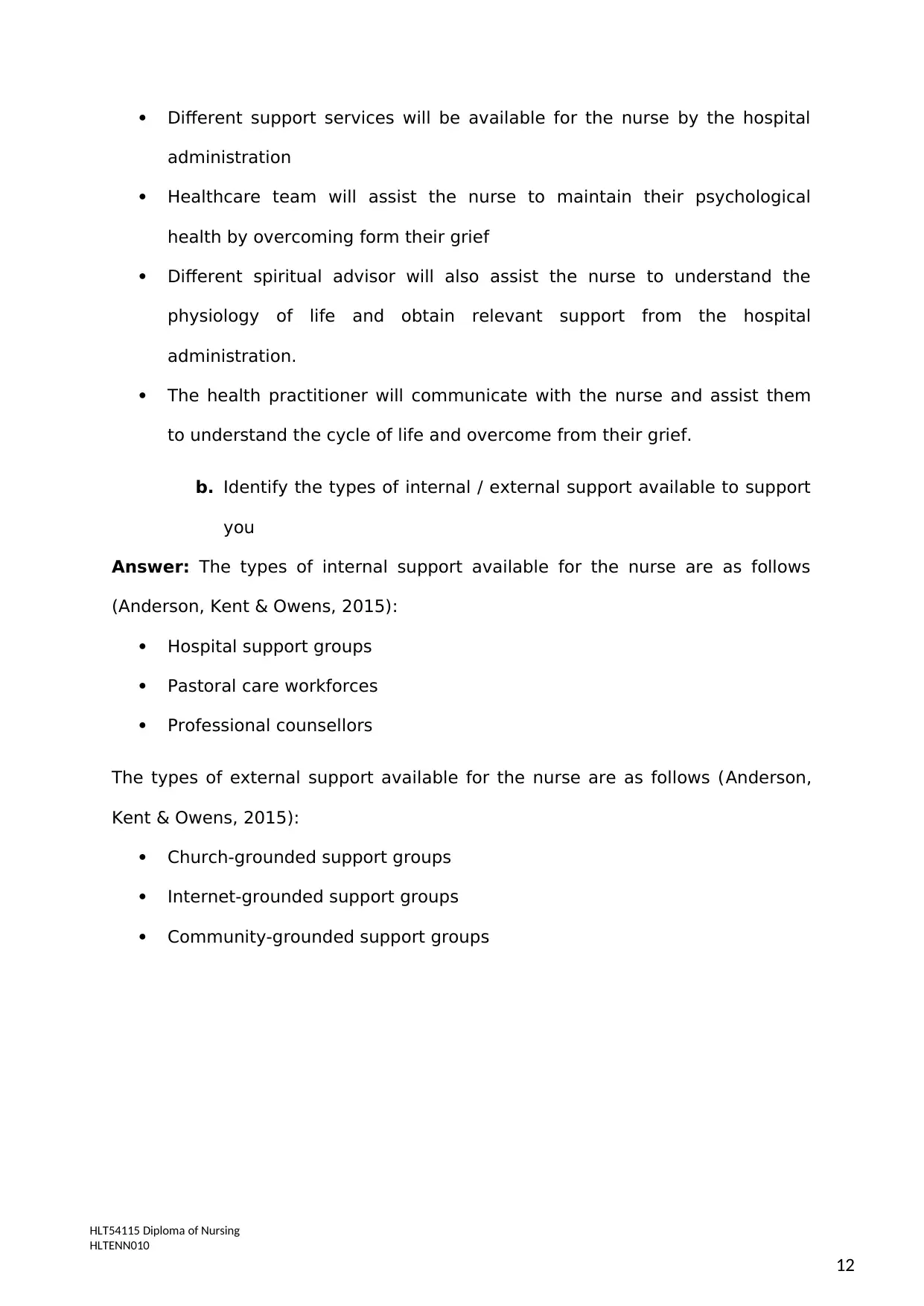
Student Assessment
Different support services will be available for the nurse by the hospital
administration
Healthcare team will assist the nurse to maintain their psychological
health by overcoming form their grief
Different spiritual advisor will also assist the nurse to understand the
physiology of life and obtain relevant support from the hospital
administration.
The health practitioner will communicate with the nurse and assist them
to understand the cycle of life and overcome from their grief.
b. Identify the types of internal / external support available to support
you
Answer: The types of internal support available for the nurse are as follows
(Anderson, Kent & Owens, 2015):
Hospital support groups
Pastoral care workforces
Professional counsellors
The types of external support available for the nurse are as follows (Anderson,
Kent & Owens, 2015):
Church-grounded support groups
Internet-grounded support groups
Community-grounded support groups
HLT54115 Diploma of Nursing
HLTENN010
12
Different support services will be available for the nurse by the hospital
administration
Healthcare team will assist the nurse to maintain their psychological
health by overcoming form their grief
Different spiritual advisor will also assist the nurse to understand the
physiology of life and obtain relevant support from the hospital
administration.
The health practitioner will communicate with the nurse and assist them
to understand the cycle of life and overcome from their grief.
b. Identify the types of internal / external support available to support
you
Answer: The types of internal support available for the nurse are as follows
(Anderson, Kent & Owens, 2015):
Hospital support groups
Pastoral care workforces
Professional counsellors
The types of external support available for the nurse are as follows (Anderson,
Kent & Owens, 2015):
Church-grounded support groups
Internet-grounded support groups
Community-grounded support groups
HLT54115 Diploma of Nursing
HLTENN010
12
⊘ This is a preview!⊘
Do you want full access?
Subscribe today to unlock all pages.

Trusted by 1+ million students worldwide
1 out of 16
Related Documents
Your All-in-One AI-Powered Toolkit for Academic Success.
+13062052269
info@desklib.com
Available 24*7 on WhatsApp / Email
![[object Object]](/_next/static/media/star-bottom.7253800d.svg)
Unlock your academic potential
Copyright © 2020–2025 A2Z Services. All Rights Reserved. Developed and managed by ZUCOL.





